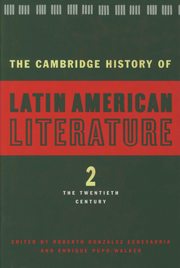Book contents
- Frontmatter
- Introduction to Volume 2
- 1 Modernist poetry
- 2 Modernist prose
- 3 The Vanguardia and its implications
- 4 The literature of Indigenismo
- 5 Afro-Hispanic American literature
- 6 The Criollista novel
- 7 The novel of the Mexican Revolution
- 8 The Spanish American novel from 1950 to 1975
- 9 The Spanish American novel: recent developments, 1975 to 1990
- 10 Spanish American poetry from 1922 to 1975
- 11 The modern essay in Spanish America
- 12 Literary criticism in Spanish America
- 13 The autobiographical narrative
- 14 The twentieth-century short story in Spanish America
- 15 Spanish American theatre in the twentieth century
- 16 Latin American (Hispanic Caribbean) literature written in the United States
- 17 Chicano literature
- Index
- Bibliographies
- References
8 - The Spanish American novel from 1950 to 1975
Published online by Cambridge University Press: 28 March 2008
- Frontmatter
- Introduction to Volume 2
- 1 Modernist poetry
- 2 Modernist prose
- 3 The Vanguardia and its implications
- 4 The literature of Indigenismo
- 5 Afro-Hispanic American literature
- 6 The Criollista novel
- 7 The novel of the Mexican Revolution
- 8 The Spanish American novel from 1950 to 1975
- 9 The Spanish American novel: recent developments, 1975 to 1990
- 10 Spanish American poetry from 1922 to 1975
- 11 The modern essay in Spanish America
- 12 Literary criticism in Spanish America
- 13 The autobiographical narrative
- 14 The twentieth-century short story in Spanish America
- 15 Spanish American theatre in the twentieth century
- 16 Latin American (Hispanic Caribbean) literature written in the United States
- 17 Chicano literature
- Index
- Bibliographies
- References
Summary
A radical shift in the way in which history and literature were conceived, interpreted, and written produced a change in the self-perception of Spanish American novelists between 1950 and 1975. The development of the cities, the coming of age of a large middle class, the Cuban Revolution, the Alliance for Progress, an increase in communication between the countries of Latin America, the greater importance of the mass media, and a greater attention to Latin America from Europe and the United States, contributed to this change. The most important political events of the period were the Cuban Revolution in 1959 and the Chilean coup d’état in 1973, but there were also others that affected writing, as they generated explanations, testimonies, or served as a troubling background: the fall of General Perón in Argentina, the protracted violent struggle of the urban guerrillas, brutally repressed in Argentina and Uruguay, and the unending violence in Colombia. These events are more than simply a framework in which to place the literary production of this period. Most of the novelists studied in this chapter believe there is a political and social discourse that only shows its weakness when exposed in the literary text. Their novels are engaged in an intense dialogue not only with other works of literature, but also with oral tradition, speech-writers, police reports, priests, and all defenders of blind orthodoxy. A history of this period must start by stating that history itself became problematic since the new generations questioned the traditional version of history and sought to replace it with their own, a more hesitant, shaded, and distrustful one than the clear-cut oppositions that prevailed before.
- Type
- Chapter
- Information
- The Cambridge History of Latin American Literature , pp. 226 - 278Publisher: Cambridge University PressPrint publication year: 1996
References
- 2
- Cited by



